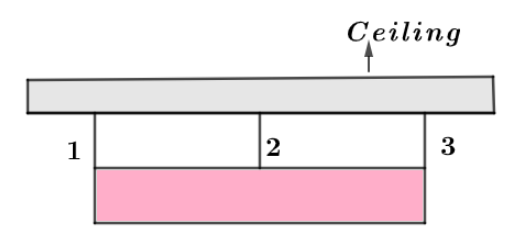
Answer
375.9k+ views
Hint: In order to find tensions in wires , we need to balance the all forces acting on three wires and weight acting on ceiling in downward direction and in order to achieve the same length in all three wires their change in length must be the same.
Complete step by step answer:
Let ${F_1}$ , ${F_2}$ and ${F_3}$ be the tension forces on three wires respectively. And their change in length is denoted as \[\Delta {L_1}\] , $\Delta {L_2}$ and $\Delta {L_3}$ .Now, balancing all three forces with force of gravity as;
${F_1} + {F_2} + {F_3} = 300 \times 9.8$
$\Rightarrow {F_1} + {F_2} + {F_3} = 2940$
And also, ${F_1} = {F_3}$ so we can write,
${F_2} = 2940 - 2{F_1} \to (i)$
And we also know that, from modulus of elasticity of steel as given
\[{F_1} = {F_3} = {F_2} + \dfrac{{dAE}}{L}\]
\[\Rightarrow {F_1} = {F_2} + \dfrac{{dAE}}{L}\]
Put, the value of ${F_2}$ from equation $(i)$ in above equation, we get
$3{F_1} = 2940 + \dfrac{{dAE}}{L} \to (ii)$
Here we have given that,
$d = 6\,mm = 0.006\,m$
$\Rightarrow A = 2 \times {10^{ - 6}}\,{m^2}$
$\Rightarrow E = 200 \times {10^9}\,N{m^{ - 2}}$
$\Rightarrow L = 2\,m$
On putting these parameters value in equation $(ii)$ we get,
$3{F_1} = 2940 + \dfrac{{6 \times 2 \times 200}}{2}$
$\Rightarrow 3{F_1} = 2940 + 1200$
$\Rightarrow {F_1} = \dfrac{{4140}}{3}$
$\therefore {F_1} = 1380\,N$
Hence tension in the wire $1$ is ${F_1} = 1380\,N$.
(b) Now, simply from equation $(i)$ we have,
${F_2} = 2940 - 2{F_1}$
Put ${F_1} = 1380\,N$ in above equation we get,
${F_2} = 2940 - 2760$
$\therefore {F_2} = 180\,N$
Hence, the tension in wire $2$ is ${F_2} = 180N$.
Note: Remember, all the tension forces on three wires are acting in the upward direction and the weight of the cylinder is downward direction. And the ceiling is in equilibrium state that’s why changes in all three wires length will be the same and hence balancing the wires and cylinder. Also $g = 9.8m{\sec ^{ - 2}}$ and $1mm = {10^{ - 3}}m$.
Complete step by step answer:
Let ${F_1}$ , ${F_2}$ and ${F_3}$ be the tension forces on three wires respectively. And their change in length is denoted as \[\Delta {L_1}\] , $\Delta {L_2}$ and $\Delta {L_3}$ .Now, balancing all three forces with force of gravity as;
${F_1} + {F_2} + {F_3} = 300 \times 9.8$
$\Rightarrow {F_1} + {F_2} + {F_3} = 2940$
And also, ${F_1} = {F_3}$ so we can write,
${F_2} = 2940 - 2{F_1} \to (i)$
And we also know that, from modulus of elasticity of steel as given
\[{F_1} = {F_3} = {F_2} + \dfrac{{dAE}}{L}\]
\[\Rightarrow {F_1} = {F_2} + \dfrac{{dAE}}{L}\]
Put, the value of ${F_2}$ from equation $(i)$ in above equation, we get
$3{F_1} = 2940 + \dfrac{{dAE}}{L} \to (ii)$
Here we have given that,
$d = 6\,mm = 0.006\,m$
$\Rightarrow A = 2 \times {10^{ - 6}}\,{m^2}$
$\Rightarrow E = 200 \times {10^9}\,N{m^{ - 2}}$
$\Rightarrow L = 2\,m$
On putting these parameters value in equation $(ii)$ we get,
$3{F_1} = 2940 + \dfrac{{6 \times 2 \times 200}}{2}$
$\Rightarrow 3{F_1} = 2940 + 1200$
$\Rightarrow {F_1} = \dfrac{{4140}}{3}$
$\therefore {F_1} = 1380\,N$
Hence tension in the wire $1$ is ${F_1} = 1380\,N$.
(b) Now, simply from equation $(i)$ we have,
${F_2} = 2940 - 2{F_1}$
Put ${F_1} = 1380\,N$ in above equation we get,
${F_2} = 2940 - 2760$
$\therefore {F_2} = 180\,N$
Hence, the tension in wire $2$ is ${F_2} = 180N$.
Note: Remember, all the tension forces on three wires are acting in the upward direction and the weight of the cylinder is downward direction. And the ceiling is in equilibrium state that’s why changes in all three wires length will be the same and hence balancing the wires and cylinder. Also $g = 9.8m{\sec ^{ - 2}}$ and $1mm = {10^{ - 3}}m$.
Recently Updated Pages
How many sigma and pi bonds are present in HCequiv class 11 chemistry CBSE

Mark and label the given geoinformation on the outline class 11 social science CBSE

When people say No pun intended what does that mea class 8 english CBSE

Name the states which share their boundary with Indias class 9 social science CBSE

Give an account of the Northern Plains of India class 9 social science CBSE

Change the following sentences into negative and interrogative class 10 english CBSE

Trending doubts
Fill the blanks with the suitable prepositions 1 The class 9 english CBSE

The Equation xxx + 2 is Satisfied when x is Equal to Class 10 Maths

In Indian rupees 1 trillion is equal to how many c class 8 maths CBSE

Which are the Top 10 Largest Countries of the World?

How do you graph the function fx 4x class 9 maths CBSE

Give 10 examples for herbs , shrubs , climbers , creepers

Difference Between Plant Cell and Animal Cell

Difference between Prokaryotic cell and Eukaryotic class 11 biology CBSE

Why is there a time difference of about 5 hours between class 10 social science CBSE




